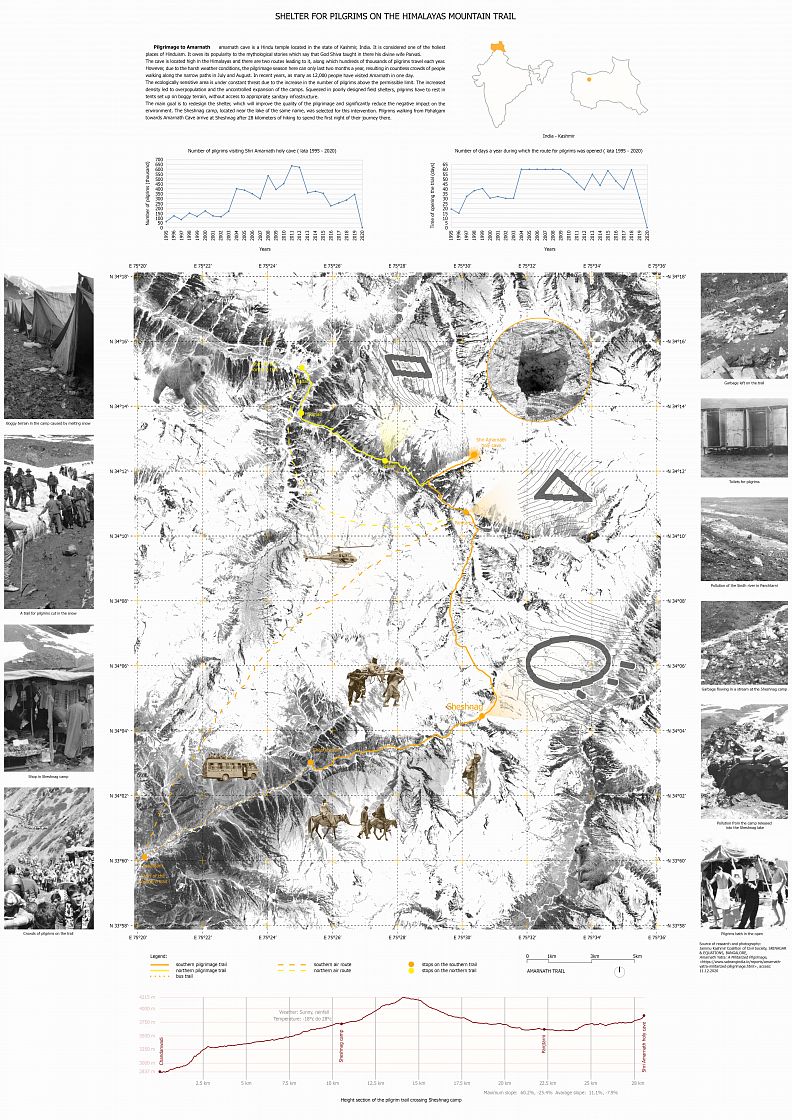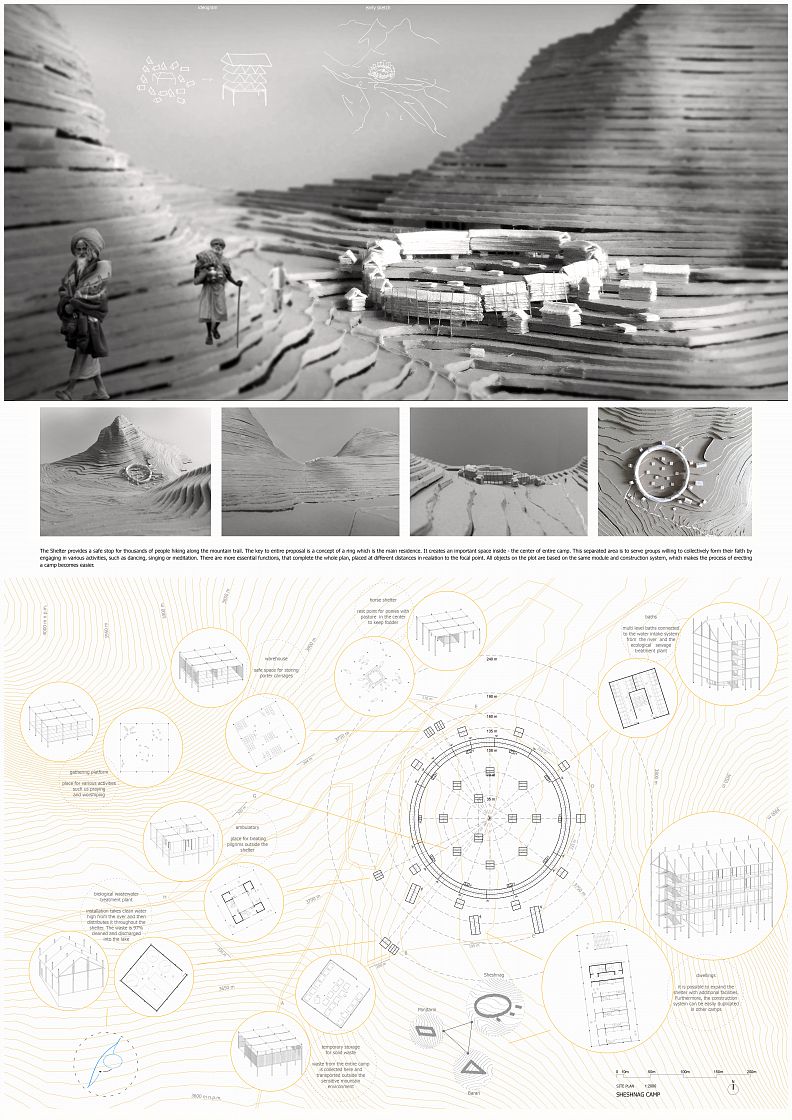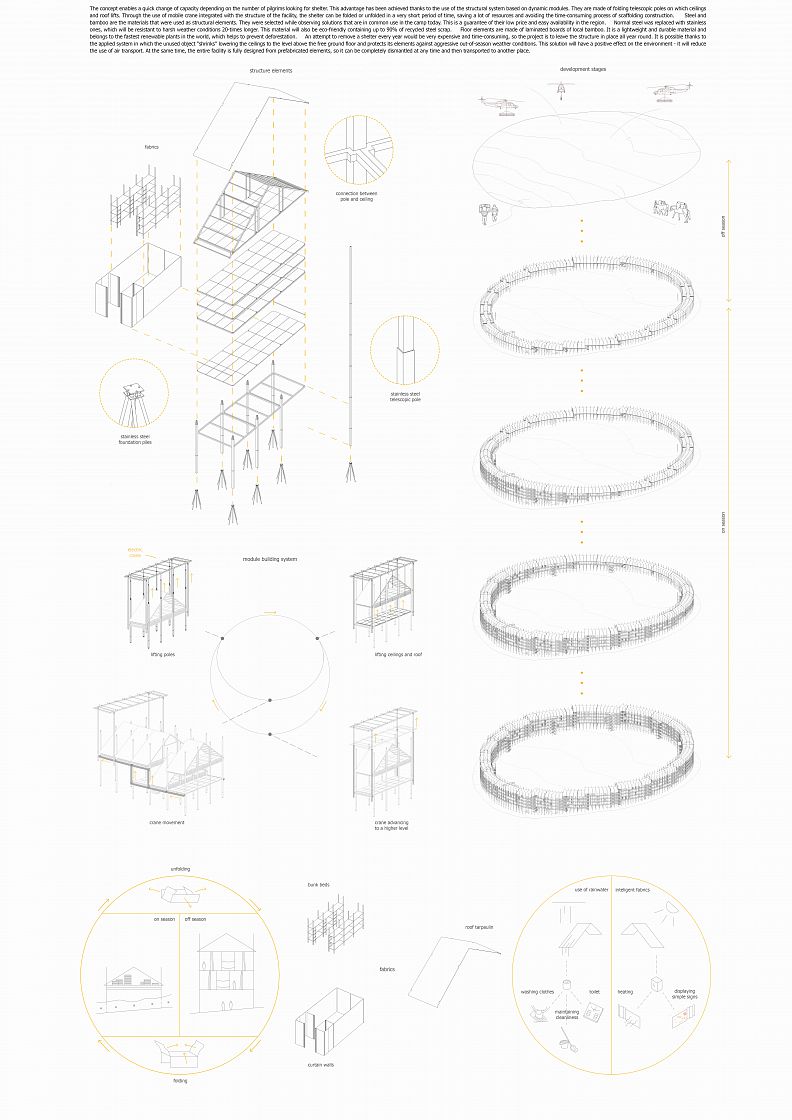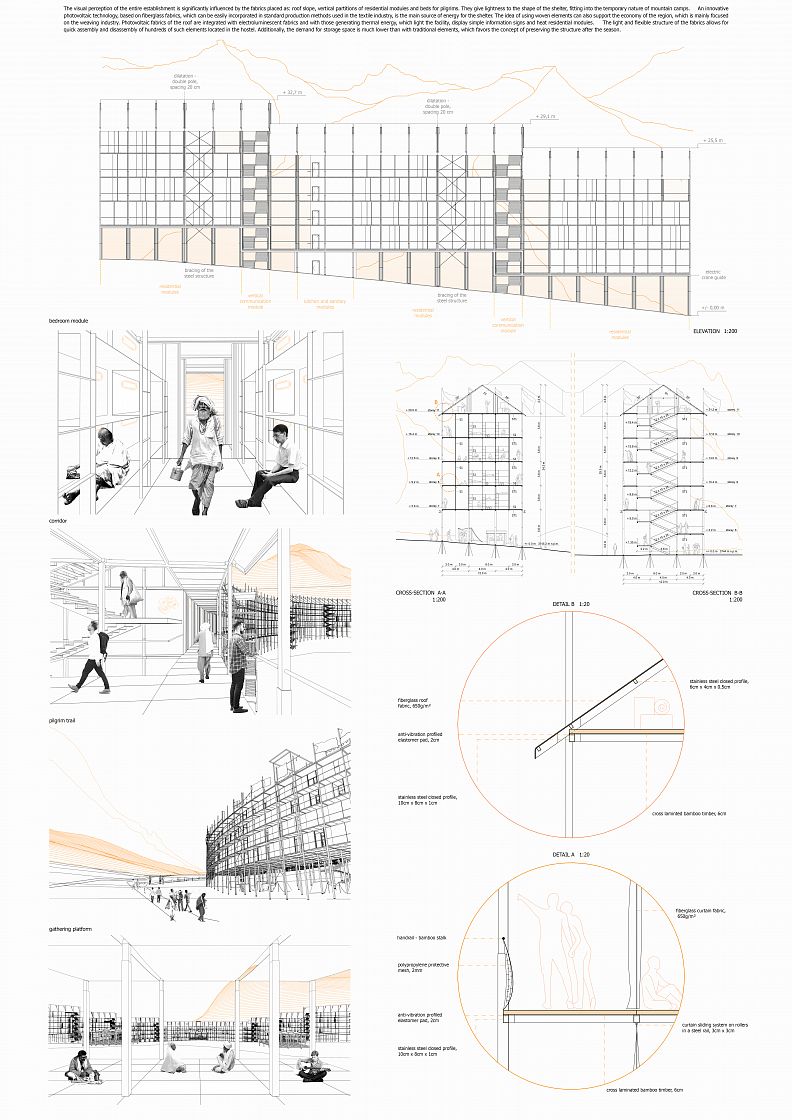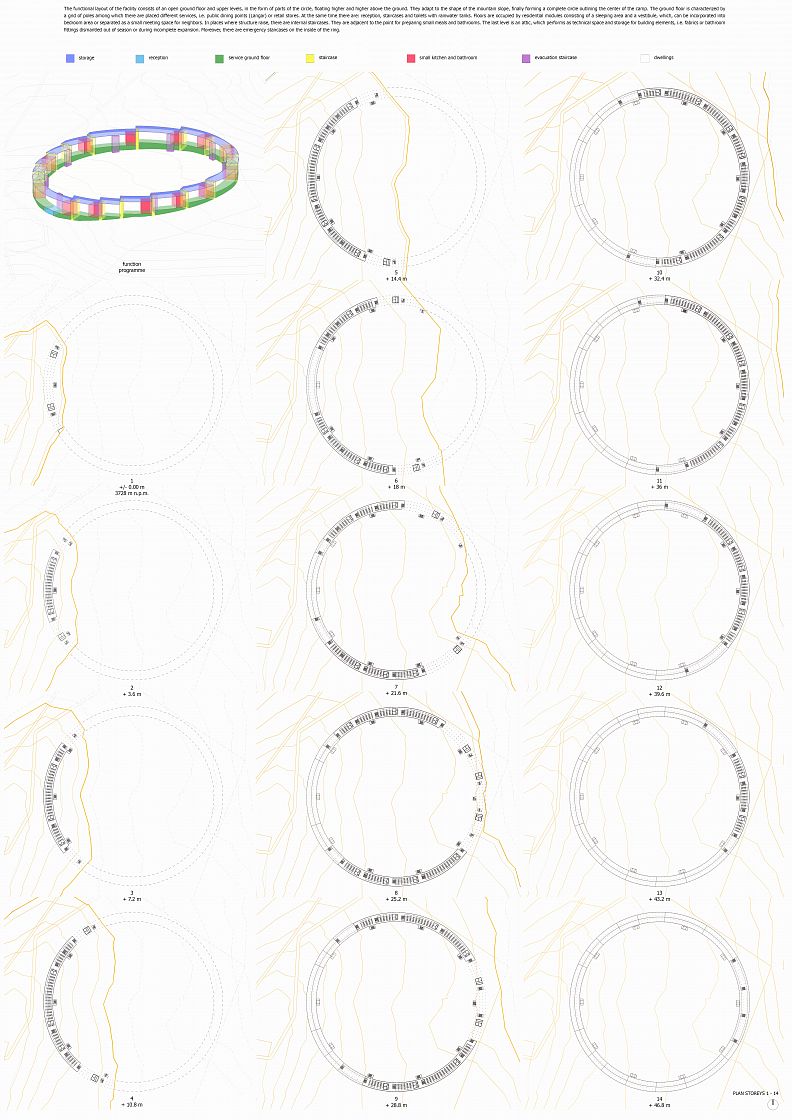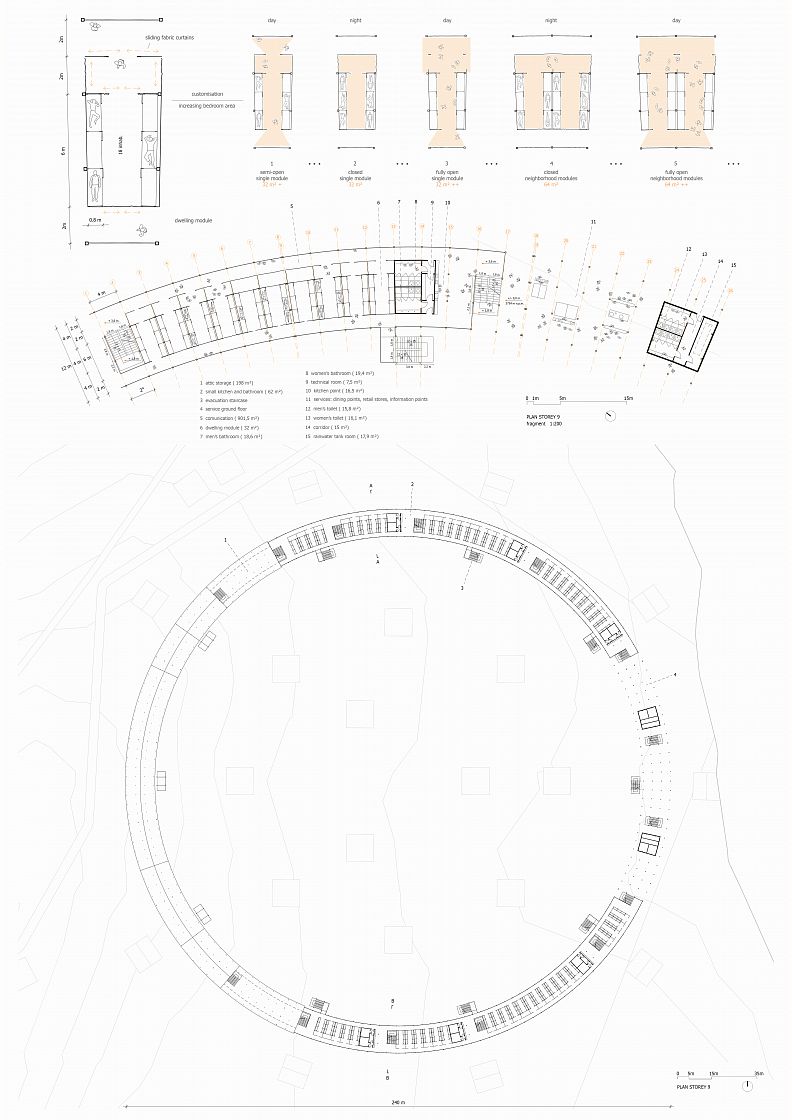Shelter for pilgrims on the Himalayas mountain trail

Project idea
Amarnath cave is a Hindu temple located in the state of Kashmir, India. It is considered one of the holiest places of Hinduism. It owes its popularity to the mythological stories which say that God Shiva taught in there his divine wife Parvati.
The cave is located high in the Himalayas and there are two routes leading to it, along which hundreds of thousands of pilgrims travel each year. However, due to the harsh weather conditions, the pilgrimage season here can only last two months a year, resulting in countless crowds of people walking along the narrow paths in July and August. In recent years, as many as 12,000 people have visited Amarnath in one day.
The ecologically sensitive area is under constant threat due to the increase in the number of pilgrims above the permissible limit. The increased density led to overpopulation and the uncontrolled expansion of the camps. Squeezed in poorly designed field shelters, pilgrims have to rest in tents set up on boggy terrain, without access to appropriate sanitary infrastructure.
The main goal is to redesign the shelter, which will improve the quality of the pilgrimage and significantly reduce the negative impact on the environment. The Sheshnag camp, located near the lake of the same name, was selected for this intervention. Pilgrims walking from Pahalgam towards Amarnath Cave arrive at Sheshnag after 28 kilometers of hiking to spend the first night of their journey there.
Project description
The Shelter provides a safe stop for thousands of people hiking along the mountain trail. The key to entire proposal is a concept of a ring which is the main residence. It creates an important space inside - the center of entire camp. This separated area is to serve groups willing to collectively form their faith by engaging in various activities, such as dancing, singing or meditation. There are more essential functions, that complete the whole plan, placed at different distances in realation to the focal point. All objects on the plot are based on the same module and construction system, which makes the process of erecting a camp becomes easier.
Technical information
The concept enables a quick change of capacity depending on the number of pilgrims looking for shelter. This advantage has been achieved thanks to the use of the structural system based on dynamic modules. They are made of folding telescopic poles on which ceilings and roof lifts. Through the use of mobile crane integrated with the structure of the facility, the shelter can be folded or unfolded in a very short period of time, saving a lot of resources and avoiding the time-consuming process of scaffolding construction. Steel and bamboo are the materials that were used as structural elements. They were selected while observing solutions that are in common use in the camp today. This is a guarantee of their low price and easy availability in the region. Normal steel was replaced with stainless ones, which will be resistant to harsh weather conditions 20-times longer. This material will also be eco-friendly containing up to 90% of recycled steel scrap. Floor elements are made of laminated boards of local bamboo. It is a lightweight and durable material and belongs to the fastest renewable plants in the world, which helps to prevent deforestation. An attempt to remove a shelter every year would be very expensive and time-consuming, so the project is to leave the structure in place all year round. It is possible thanks to the applied system in which the unused object "shrinks" lowering the ceilings to the level above the free ground floor and protects its elements against aggressive out-of-season weather conditions. This solution will have a positive effect on the environment - it will reduce the use of air transport. At the same time, the entire facility is fully designed from prefabricated elements, so it can be completely dismantled at any time and then transported to another place.
The visualperception of the entire establishment is significantly influenced by the fabrics placed as: roof slope, vertical partitions of residential modules and beds for pilgrims. They give lightness to the shape of the shelter, fitting into the temporary nature of mountain camps. An innovative photovoltaic technology, based on fiberglass fabrics, which can be easily incorporated in standard production methods used in the textile industry, is the main source of energy for the shelter. The idea of using woven elements can also support the economy of the region, which is mainly focused on the weaving industry. Photovoltaic fabrics of the roof are integrated with electroluminescent fabrics and with those genereting thermal energy, which light the facility, display simple information signs and heat residential modules. The light and flexible structure of the fabrics allows for quick assembly and disassembly of hundreds of such elements located in the shelter. Additionally, the demand for storage space is much lower than with traditional elements which favors the concept of preserving the structure after the season.
The functional layout of the facility consists of an open ground floor and upper levels, in the form of parts of the circle, floating higher and higher above the ground. They adapt to the shape of the mountain slope, finally forming a complete circle outlining the center of the camp. The ground floor is characterized by a grid of poles among which there are placed different services, i.e. public dining points (Langar) or retail stores. At the same time there are: reception, staircases and toilets with rainwater tanks. Floors are occupied by residential modules consisting of a sleeping area and a vestibule, which, can be incorporated into bedroom area or separated as a small meeting space for neighbors. In places where structure raise, there are internal staircases. They are adjacent to the point for preparing small meals and bathrooms. The last level is an attic, which performs as technical space and storage for building elements, i.e. fabrics or bathroom fittings dismantled out of season or during incomplete expansion. Moreover, there are emergency staircases on the inside of the ring.
